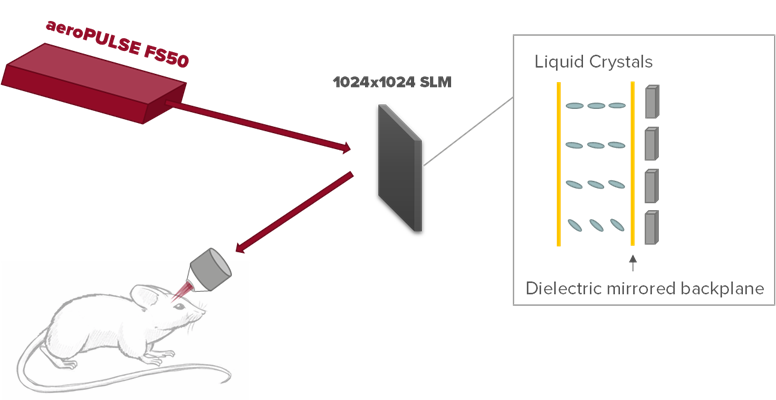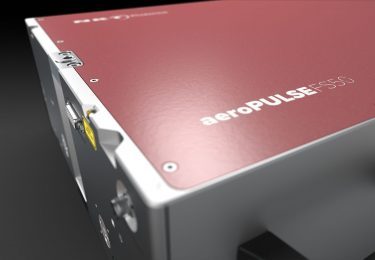Using near-IR femtosecond light pulses to activate tens to hundreds of neurons in the brain is possible via the use of Spatial Light Modulators (SLMs). These can generate a holographic 3D pattern of nearly diffraction-limited or soma-sized spots in the brain. To further replicate naturalistic sequences involving several neurons that are desynchronized, the SLM needs to be able to switch patterns on millisecond timescales or less.
The new 1024×1024 SLM from Meadowlark Optics released at the Society for Neuroscience meeting in 2022 has best-in-class refresh times of <1.7 ms with a comparable large field of view and high phase stability. In the following, we discuss whether this SLM can withstand the high peak intensities from ultrafast fiber laser pulses to be used for optogenetics.
A team from Meadowlark Optics tested the new SLM with our aeroPULSE FS50 at the University of California, Berkeley. The results show that the SLM in its standard configuration did not get damaged for beam sizes of 10 mm or more up to the full power of the FS50. This case study provides further guidance for neuroscientists planning to implement the 1024×1024 SLM for optogenetic purposes.
Encoding neuronal signaling and network dynamics is vital for our understanding of the brain. Questions to address are: How many cells need to be activated to generate a neural response, and in which temporal sequence or spatial proximity?
In this context, ultrashort light pulses from our aeroPULSE FS laser series are used to induce neural activity in defined cell types, such as photo-sensitive microbial opsins, that either generate or suppress neuronal activity. Using the 1030 nm wavelengths of the aeroPULSE and multiphoton excitation has the added advantage of stimulating deeper in highly scattering brain tissue.
To obtain spatial control over the activation of several neurons, the output of the laser is converted into a holographic image in the brain via a Spatial Light Modulator (SLM). A specific phase mask generated by the SLM enables the shaping of optical wavefronts to generate 3D objects in the imaging space.
With the aid of computer-generated holograms, it is possible to display a phase mask on the SLM that generates a 3D pattern of spots in the brain that is then used to activate specific sets of neurons optogenetically.
The combination of an SLM with high pulse energies at a high repetition rate from the aeroPULSE laser allows for the simultaneous activation of up to hundreds of neurons in the brain. See our application note on optogenetics for more information on stimulation modalities such as spiral scanning and temporal focusing.

Temporal control over the activation of the same neurons in a network can be readily accomplished by gating the laser. As a figure of merit, for repetition rates optimally around 1-2 MHz, it takes about 1-5 ms to spike activity in a neuron, depending on the fluorophore, expression density, and other factors.
However, the more interesting and general case is to replay complex naturalistic patterns involving several neurons that are desynchronized. This requires the phase mask to switch as fast as possible to allow for the stimulation of the next set of neurons. The resulting stream of distinct holographic patterns requires high refresh rates for the SLM.
Additionally, a high pixel count for the SLM is desired to provide optical control over much of the field of view in conventional two-photon microscopes. The new 1024×1024 SLM from Meadowlark Optics offers this large field of view with best-in-class liquid crystal refresh times of <1.7 ms and high phase stability.
The question is whether the newly designed SLM withstands the peak intensity levels required for multiphoton optogenetics involving tens to hundreds of neurons and which setting is optimal in terms of thermal management of the SLM.
This is particularly important for temporally focused excitation where higher average powers can be applied. For this purpose, a team of scientists from Meadowlark Optics stress-tested the SLM using NKT Photonics’ aeroPULSE FS50 at the University of California, Berkeley.
The test setup
The diagram below illustrates the setup used. Experiments were performed by illuminating the 17.4 mm2 active area of the SLM with a beam size of 10 mm.
The modulation depth was determined by writing a series of binary phase gratings to the SLM and measuring either the 0th-order or 1st-order intensity as each phase grating is applied.
The gratings were stripes, with 4 pixels per stripe. Modulation depth was analyzed by applying a variable grayscale decremented from 255 (max. voltage) down to zero.
The repetition rate of the aeroPULSE FS50 was set to 1.2 MHz and the output power was varied with the internal AOM up to 50 W. The individual pulses had a duration of 404 fs, and the recorded intensity from the detector is the average of 10,000 measurements recorded every 0.5 ms.

The test results
Remarkably, no damage was observed in this series, with peak intensities up to 263 MW/cm2 at full output power. This holds true even for the standard configuration without liquid cooling and/or dielectric mirror.
We did observe a change in modulation depth in the standard configuration with increased input power. This is related to heating effects and, while a full wavelength modulation was still available at any input power, care needs to be taken when calibrating the SLM, e.g., by applying the same laser power of the stimulation experiment while recording the calibrating curve.
To generate high peak intensities for illustrating the extreme case with regard to damage thresholds, the illumination was demagnified into a 1 mm beam. When applying liquid cooling and with the backplane of the SLM being converted into a flat dielectric mirror, no damages were observed in any scenario using the aeroPULSE FS50.
More astonishingly, even in the extreme case of up to 27 GW/cm2 peak intensity established at full power and with reduced beam size on the SLM (1 mm beam size vs 17.4 mm2 array size), the modulation depth did not change with peak intensity. This ensures optimal operation of the SLM at any power level of the aeroPULSE FS50 and that one calibration curve can be applied for any output power setting of the laser.

The only scenario in which damage was observed included high peak intensities (1 mm beam size) and no dielectric mirror as the backplane. In this case, the heat generated at the backplane did rise quickly with increased peak intensity until the damage was observed for >16 GW/cm2 (>30 W, 1 mm).
Based on these data and experiments, neuroscientists who plan to incorporate the new 1024×1024 SLM from Meadowlark can use it up to the full power of the FS50 – if the beam size on the active area of the SLM is 10 mm or larger.
To lower the risk of damage for smaller beam sizes and a constant calibration curve at any power setting of the aeroPULSE FS50, we recommend opting for liquid cooling and the dielectric mirrored backplane.
The test results at a glance
| aeroPULSE FS50 | SLM only | SLM and liquid cooling | SLM, liquid cooling, and dielectric mirrored backplane |
| Damage-free for <250 MW/cm2 (10 mm, 50 W) | Yes | Yes | Yes |
| Damage-free for <27 GW/cm2 (1 mm, 50 W) | No | No | Yes |
| Modulation Depth independent of laser power | No | No | Yes |



